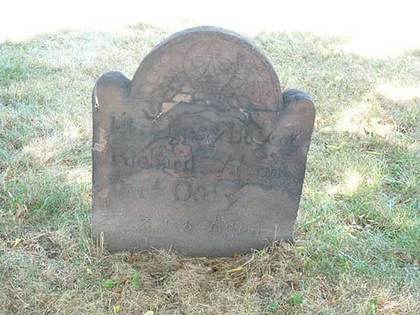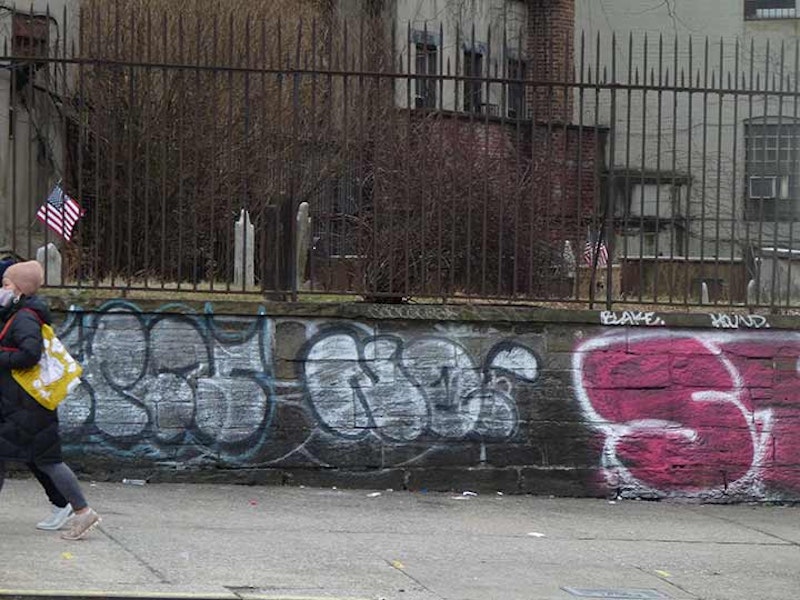Passersby ignore this small cemetery on St. James Pl., just south of Chatham Square in Chinatown. Besides Trinity Church’s two cemeteries, one downtown and one uptown in Hamilton Heights at W. 155th St., there are three smaller cemeteries in Manhattan, all belonging to the Shearith Israel Spanish and Portuguese Synagogue. (There are many hidden and buried cemeteries around town, such as the 1990 discovery and newly-renovated African Burial Ground near Federal Plaza; a previously buried tombstone was unearthed in Washington Square during its renovations in 2009.)
This, the oldest extant cemetery in Manhattan, was founded in 1682 by Shearith Israel, NYC’s first Jewish congregation.
During Peter Stuyvesant’s era, Shearith (“Remnant of”) Israel was the city’s only Jewish congregation, founded by exiled Spanish and Portuguese Jews in 1654. While the Dutch colony of New Amsterdam permitted freedom of faith, an oddity in that era, public synagogues weren’t permitted until several decades later, with Shearith founding the first of its five temples in 1730 (their present one is on W. 70th St). Shearith Israel’s first cemetery was founded at what became the Wall Street area in 1656, and while that one’s long vanished, this one, dating to 1682, is still here, and contains the oldest tombstone in the city (Benjamin Bueno de Mezquita), dated 1683.
You can get some decent pictures by poking the camera through the fence and zooming in; there’s no schedule for when the gate is opened. There are luminaries here—18 Revolutionary War soldiers and patriots, including one of the 14 clergymen to officiate at President Washington’s inauguration, Rabbi Gershom Mendes Seixas: his preaching had made such an impression that in 1789 he was asked to deliver sermons at St. Paul’s Chapel (which still stands at Broadway and Vesey St.), and officiated at the inauguration a year later. This was an early example of ecumenism in the nascent nation.
As Shearith Israel moved gradually uptown it established two other cemeteries. A small slice of the first, on W. 11th St. near 6th Ave., is still there, as is the second, on W. 21st west of 6th. They make surprising discoveries for people who were unaware that cemeteries exist in Manhattan.

This smallest cemetery in Brooklyn, the “Revolutionary Cemetery” in Bay Ridge, at the corner of Narrows Ave. and Mackay Pl., was founded in 1725 by Dutch immigrant William Harmans Barkaloo and likely served as a family farm graveyard. At the time, the nearest road was the Road from Gowanus, which evolved into the present 3rd Ave.
The “revolutionary” appellation comes from a plaque erected in 1962 on the protective gate, which indicates that several Revolutionary War veterans are buried here; though some historians dismiss the claim as spurious, others say that William Barkaloo’s sons, Harmans and Jacques, fought in the Battle of Brooklyn, which raged in Bay Ridge and throughout the towns of New Utrecht and Brooklyn. The last burial took place in 1848.
The Barkaloo Cemetery is still historic since it’s the only family plot in Brooklyn not part of a larger cemetery. There are a number remaining in the Bronx and Queens (Lawrence Cemeteries in Astoria and Bayside and Pullis Cemetery, as well as the Alsop plot in Calvary Cemetery). The Barkaloos lived in Bay Ridge well into the 20th Century.

Richard Alsop’s gravestone, dated 1718, is the oldest in Calvary Cemetery in western Queens. The Alsop family burial site, in a southern corner of the cemetery in view of the Kosciusko Bridge, pre-existed Calvary by over a century and was incorporated into a Calvary when the land it stood on was purchased by St. Patrick’s Cathedral in 1848. (In nearby Mount Zion Cemetery, you’ll find the equally-old Betts family cemetery. Other unusual cemetery placements are the Drake Park cemetery in Hunts Point, Bronx, and the Quaker cemetery in Prospect Park where Montgomery Clift was laid to rest.
Richard Alsop had been bequeathed the land by his cousin, British immigrant Thomas Wandell. Hannah Alsop, widow of Richard, features a death’s head on her stone. These are unusual in NYC, since in general, skulls were replaced by angels in the late-1700s. The chiseled lettering on these brownstone markers has held up well for over 300 years.
Several members of the Alsop family were interred here between 1718 and the late-1880s, as well as the family’s slaves, whose graves are unmarked. The family was prominent in Newtown, and married into the Fish family and King family, which produced a NYS Governor and 1816 Presidential candidate Rufus King, whose mansion stands in Jamaica. His wife was neé Mary Alsop. The last of the Alsops died without issue in the 1880s.

West Farms Cemetery, on Bryant Ave. and E. 180th St., is a designated Bronx landmark and has occupied this space since 1815. There are just 40 soldiers buried here in a plot that can accommodate more interments. The first soldier buried here was Sam Adams (not the Sam Adams) a veteran of the War of 1812; the last, Valerino Tulosa, fought in World War I. The cemetery was founded by John Butler and the Butler family retained possession until 1953. Since then, NYC has done a middling job of maintaining it.

As it enters the southern end of Port Richmond in Staten Island, Forest Ave. takes a southwest turn and runs between two of the many shopping centers in this part of town. There’s one mini-mall here, just east of Livermore Avenue where it meets Forest, that’s of particular interest. To explain why take a look at a map of the area from 1873.

In 1873 Forest Ave. in Port Richmond was still called Cherry Lane and at that bend you find a cemetery marked AFME, for African Methodist Episcopal. It was the cemetery for a long-vanished AFME church in the area, and the only cemetery in this part of Staten Island that would admit African-Americans. The church and cemetery were founded in the 1850s, with the cemetery admitting interments until the early-20th century. Eventually the site was paved over, additional streets laid out, and a filling station occupying the former cemetery property. Some of the interred may have been moved to Moravian Cemetery but many more stayed put, including Benjamin Perine, the last slave was born on Staten Island, who was buried here in 1900. He was born in the Jewett-Taintor House, which formerly stood at 2105 Richmond Terrace in Port Richmond.
My friend and former member of the Greater Astoria Historical Society executive board, Heather Quinlan, is preparing a film to raise consciousness about the existence of the cemetery and has interviewed some of Benjamin Perine’s relatives. Here is a report from WNBC TV in October 2021. While a short section of Forest Avenue was sub-named Benjamin Perine Way in May 2023, it’s hoped that a larger memorial can be erected for the Americans interred here beneath a shopping mall, as well as other forgotten cemeteries in New York City.
—Kevin Walsh is the webmaster of the award-winning website Forgotten NY, and the author of the books Forgotten New York (HarperCollins, 2006) and also, with the Greater Astoria Historical Society, Forgotten Queens (Arcadia, 2013)

